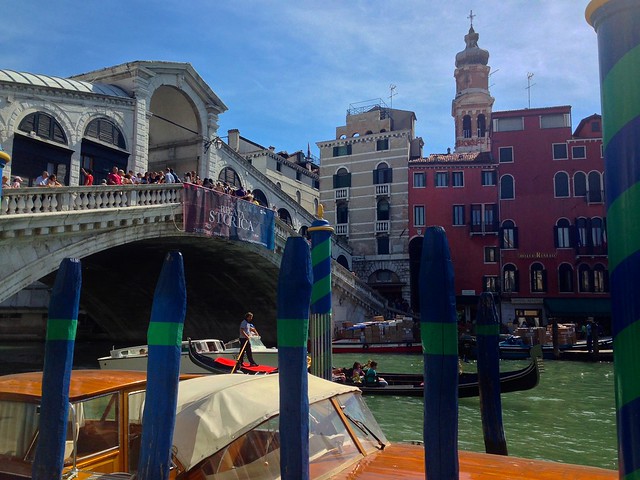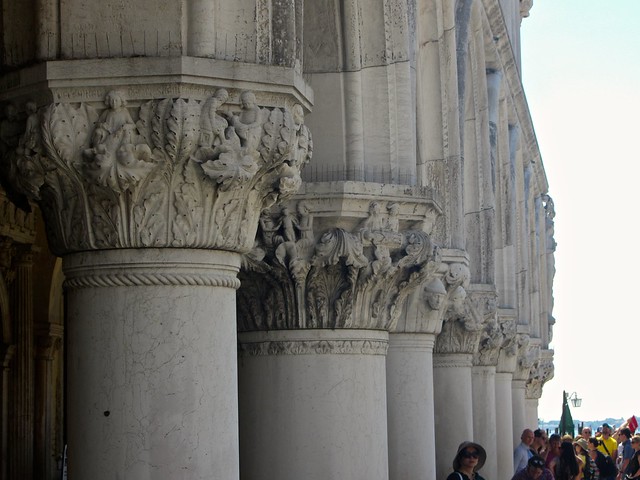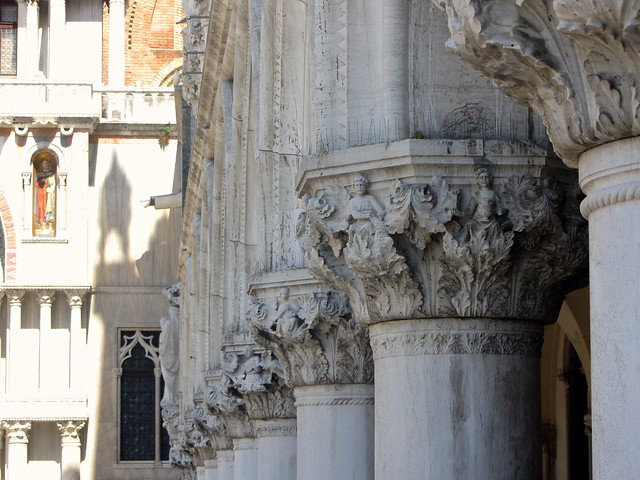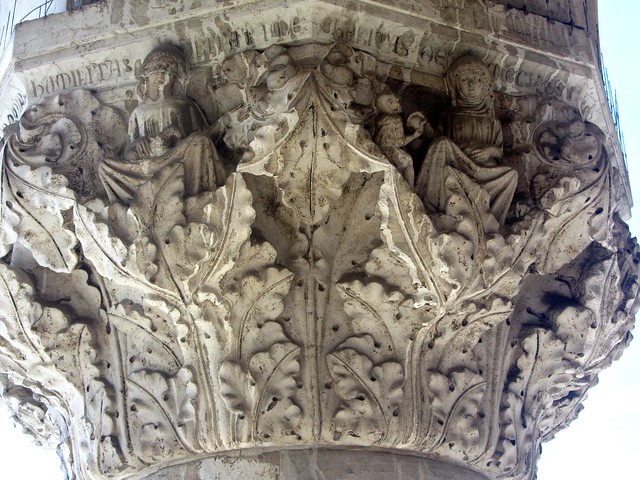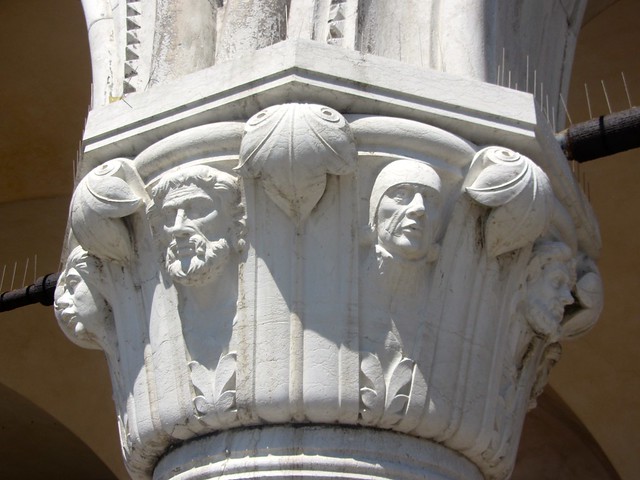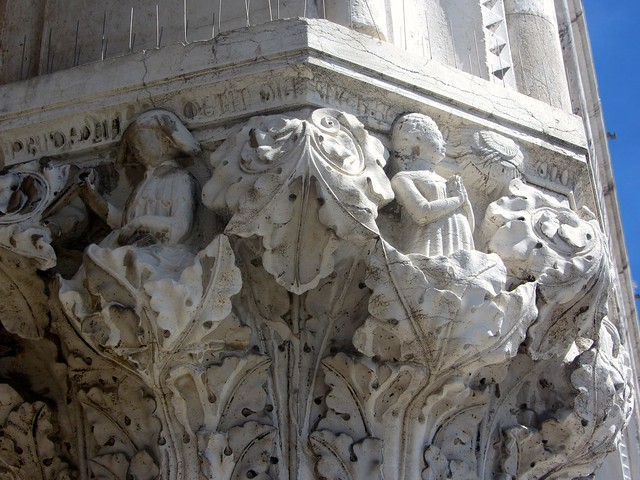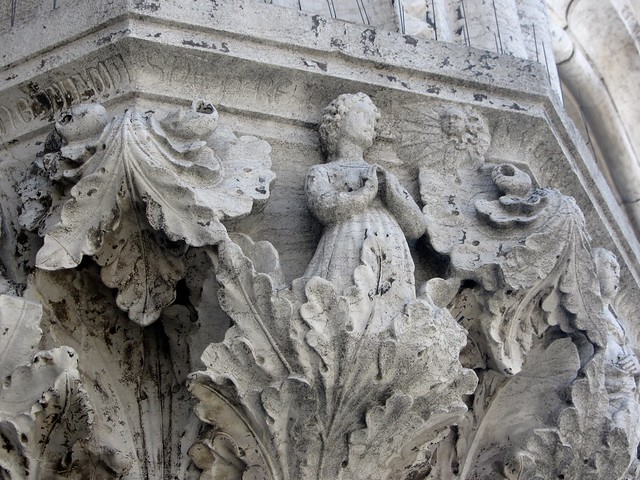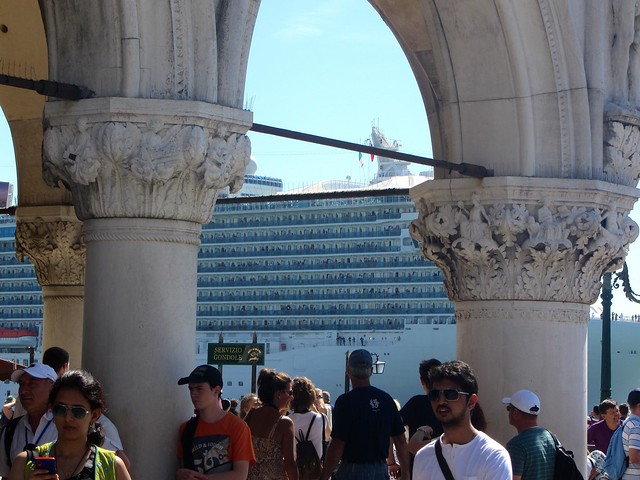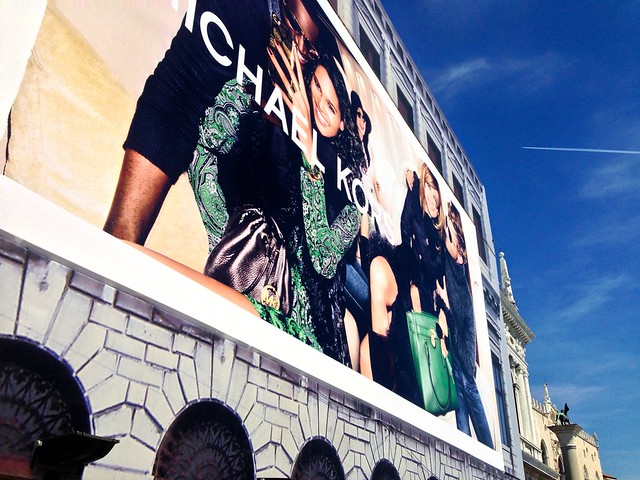We had finally made it, but we didn't have a firm plan for our time in Venice. We both like just being in a city, simply walking around, seeing the buildings and the people, and picking up the feeling of the place. We don't like crowds or tourists - or especially large crowds of tourists - so we tend to avoid the most touristy spots when we travel. We had both been in Venice before, so we didn't have a pressing need to check specific things off a list.
But as we headed out in the morning, we found ourselves on the way to the Rialto bridge and Piazza San Marco anyhow. It was still morning, so we decided we might as well see them before they got too busy.
The Rialto was already packed.
We weren't sure if we really wanted to do Piazza San Marco, but the streets in that part of town all tend to lead there. It too was busy but it's such a large space that it didn't feel crowded - even if it was full of tourists doing tourist things:
We got there just in time for the giant copper figures to hammer out the twelve bells of noon:
But our real target was the Ducal Palace. As I mentioned earlier, we had been dipping into John Ruskin's "The Stones of Venice" for context, and a key early part of the book is devoted to the Ducal Palace.
Ruskin argues that there are three main architectural traditions in the (Western) world: the Classical (i.e. ancient Greek, Roman, and Byzantine), the Lombard (i.e. northern Europe), and the Arab (i.e. Middle Eastern and North African), and that these three traditions met and mixed most perfectly in Venice. As Ruskin more feverishly puts it:
Opposite in their character and mission, alike in their magnificence of energy, they came from the North, and from the South, the glacier torrent and the lava stream: they met and contended over the wreck of the Roman empire; and the very centre of the struggle, the point of pause of both, the dead water of the opposite eddies, charged with embayed fragments of the Roman wreck, is VENICE.
The Ducal palace of Venice contains the three elements in exactly equal proportions - the Roman, Lombard, and Arab. It is the central building of the world.
So here we were, with the text and the building together:
A bit later in the book, Ruskin uses the Ducal Palace as one of key examples of his main point: that, counter to what people had been saying for centuries, the switch from Medieval Gothic to Renaissance Neo-Classicism was not in fact a 'rebirth' but was instead a big step backwards for art and architecture. To Ruskin, Gothic architecture was a natural expression of individual craftsmen and an echo of their living culture; while the Renaissance, in slavishly trying to mimic ancient Greek and Roman masters, devalued its own contemporary cultural context while turning artistic craftsmen into mere copyists.
Ruskin may have been eccentric, but his strongly worded and extensively argued points found a willing audience in a century that was facing increasingly dehumanizing factory labour and mass production. He was a founding influence on William Morris and the Arts and Crafts movement, which led to a later cultural obsession with all things medieval and gothic (something we experienced much more thoroughly a few weeks later in France).
Ruskin posits, essentially, that everything fell apart in Venice after 1418 or so. Before, it was a brave vibrant republic; after, a slowly collapsing oligarchy. This coincided with a shift in cultural attitudes and the rise of what would later be called the Renaissance.
Conveniently for Ruskin's argument, half of the Ducal palace was built around 1340 while the other half was built after 1424. Therefore, the evidence for his argument can be found simply by comparing the two halves. As he says:
The difference in age has been gravely disputed by the Venetian antiquaries, who have examined many documents on the subject, and quoted some which they never examined. I have myself collated most of the written documents, and one document more, to which the Venetian antiquaries never thought of referring, —the masonry of the palace itself.
Since we were there, we pulled up the pertinent chapter on our Kindle and took a look at the evidence ourselves:
SECTION XLVI. Now, the architect who built under Foscari, in 1424 (remember my date for the decline of Venice, 1418), was obliged to follow the principal forms of the older palace. But he had not the wit to invent new capitals in the same style; he therefore clumsily copied the old ones.
Here are the "older" columns, on the seaward side (although that one in the front is the first of the "newer" ones).
Here are the "newer" columns, on the basilica side.
SECTION XLVII. ... the point I have here to notice is in the copy of the ninth capital, which was decorated (being, like the rest, octagonal) with figures of the eight Virtues: - Faith, Hope, Charity, Justice, Temperance, Prudence, Humility (the Venetian antiquaries call it Humanity!), and Fortitude. The Virtues of the fourteenth century are somewhat hard-featured; with vivid and living expression, and plain every-day clothes of the time.
SECTION XLVIII. This design, then, is, rudely and with imperfect chiselling, imitated by the fifteenth century workmen: the Virtues have lost their hard features and living expression; they have now all got Roman noses, and have had their hair curled.
Certainly there is a change in the style and quality of the figures on these capitals. While it's easiest to compare the Virtues, the most striking were the capitals with the human heads peering out of them - each distinctive and strikingly authentic in features, expression, and headgear:
So we had to agree with Ruskin in this case. But we had trouble with his "clincher" argument. Here's what he says about the older "good" version of the virtue of Hope:
...and Hope is praying, while above her a hand is seen emerging from the sunbeams - the hand of God (according to that of Revelations, "The Lord God giveth them light"); and the inscription above is, "Spes optima in Deo."
Then here's what he says about the newer "bad" version:
"she is still praying, but she is praying to the sun only: The hand of God is gone."
Now, it's possible I confused my pictures, or even got confused about which columns were were supposed to compare when we were there, but looking at these, I don't see the "hand of God" in the older one (but maybe tentacles?), and while the newer one may not have a hand, it has an entire face instead. This makes it difficult to follow Ruskin in his next step:
Is not this a curious and striking type of the spirit which had then become dominant in the world, forgetting to see God's hand in the light He gave; so that in the issue, when the light opened into the Reformation on the one side, and into full knowledge of ancient literature on the other, the one was arrested and other perverted?
Certainly the art isn't as good, but the rest of his argument here just doesn't follow.
Ruskin, though, is known for his precision. His drawings are so accurate that people have used them as baselines to figure out how much notable buildings have settled or changed since the 1850s. So, were we confused? Was he changing things to support his argument, assuming most of his readers would never be able to look for themselves? Have the designs themselves been changed in the intervening 150 years, possibly in direct response to his argument?
It's hard to know the answers to these questions for sure, but the investigation gave us a new experience: instead of trying to take in the overwhelming scale of the entirety of the Piazza San Marco (not to mention the hyper-touristy crowds), we focused intently on one notable set of capitals.
I hadn't investigated this kind of building in a long time and it was good to be reminded this early in our trip that Medieval architectural decoration is not purely for looks but is loaded with meaning. Buildings become books - and we had to bring a book to a building to remember to read both.
We left Piazza San Marco pondering the differences between "idealized" and "realistic" representations, surrounded by numerous examples of each. We then turned a corner and discovered a gigantic Michael Kors poster across one of the seaward-facing walls - a feature as prominant from the water as the Ducal Palace's façade, and providing its own take on the Ideal vs. the Authentic.
